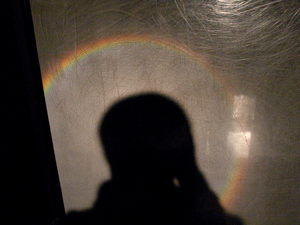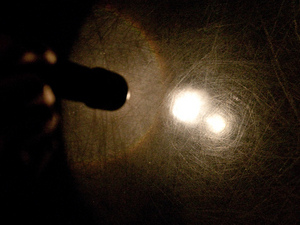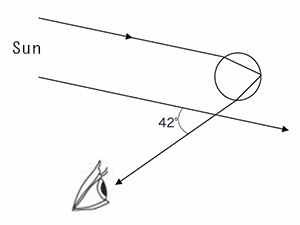Nagoya City Science Museum
TOP > Exhibition Guide > Keyword Search > Starting with "L" > light > Rainbow
Rainbow



Purpose of Exhibition
This exhibit has been created in the hope that it will help you take an interest in how a rainbow occurs.
Additional Knowledge
Water Droplets Serve as Prisms in a Natural Rainbow.
Water droplets in the atmosphere are almost spherical. When sunlight gets into them, it is refracted and reflected in the water droplets. The angle between the incident light and the reflected light from the water droplets is approximately 42 degrees (Figure 1). In other words, the reflected light can be seen on the circumference at an angle of about 42 degrees based on the visual line of the observer located in the opposite direction of the sun (Figure 2).However, the refractive index depends on the color of the light. Therefore, the water droplets decompose the sunlight into the seven component colors in the same way as prisms do (Figure 3). As a result, the water droplets disperse the sunlight into the seven colors to form a rainbow with red on the outside and purple on the inside.
Beads Serve as Prisms in the Man-Made Rainbow.
This exhibit is designed to show you this phenomenon as a simulation. A lamp, which serves as the sun, is installed on the ceiling above the entrance. And 0.3mm-in-diameter tiny plastic beads, which serve as water droplets, are pasted on the screen placed in front.Now, let's check where you must stand to see a rainbow. Not all locations allow you to see the rainbow. Rainbow-visibility varies from one person to another in terms of location. Check around to find where you must stand. Then, light the small lamp placed below the screen to form a rainbow on the screen. You'll be able to view the kind of rainbow that never occurs in nature. That is because it is impossible to view a rainbow from behind the source light in the event that the sun is the source light.See the rainbow with only one eye as well and you will notice that your left and right eyes are at variance in terms of rainbow-visibility location. So if you see the rainbow with both eyes after that, your eyes may perceive the rainbow three-dimensionally.
Difference between Natural Rainbow and Man-Made RainbowIn this room, a rainbow is formed with the use of the light of a lamp and plastic beads. It is different in the following respects from natural rainbows formed by sunlight and water droplets. Let's check the differences. The angle between the incident light and the reflected light from the water droplets (beads) is smaller. So a smaller rainbow is formed. (A rainbow can be seen at an angle of about 42 degrees in case of water droplets and at an angle of 14 to 17 degrees in case of beads. This means that a rainbow can be viewed even in a small room.)Water droplets are distributed in a thick layer, while this exhibit merely uses a line of beads. Sunlight is a parallel beam of light. But the lamp's light is radiative; therefore, the rainbow does not disappear even when you get close to the screen. In other words, you can get close to the rainbow.
Figure 1: The angle between the incident light and the reflected light from the water droplets is approximately 42 degrees.
Figure 2: The rainbow is visible on the circumference at an angle of about 42 degrees based on the visual line of the observer located in the opposite direction of the sun.
Figure 3: The refractive index depends on the color of the light. Therefore, the water droplets decompose the sunlight into the seven component colors in the same way as prisms do.
Article by Shoji Nishimoto, curator and Illustration by Mitsuko Watanabe
